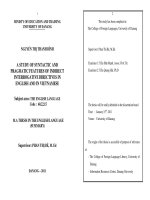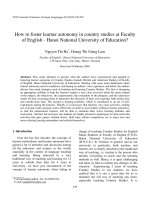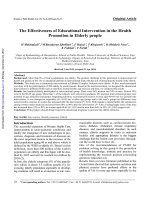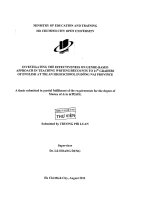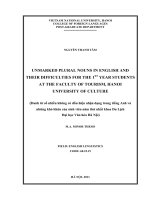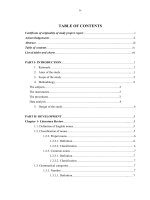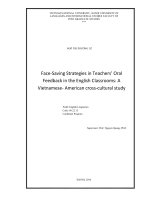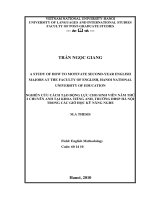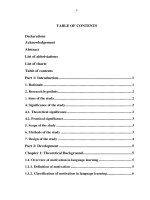Effectiveness of Indirect Corrective feedback in English writing at the Faculty of English, Hanoi National University of Education
Bạn đang xem bản rút gọn của tài liệu. Xem và tải ngay bản đầy đủ của tài liệu tại đây (615.41 KB, 57 trang )
VIETNAM NATIONAL UNIVERSITY, HANOI
UNIVERSITY OF LANGUAGES AND INTERNATIONAL STUDIES
FACULTY OF POST-GRADUATE STUDIES
NGUYỄN THỊ KHÁNH
EFFECTIVENESS OF INDIRECT CORRECTIVE
FEEDBACK IN ENGLISH WRITING
AT THE FACULTY OF ENGLISH, HANOI NATIONAL
UNIVERSITY OF EDUCATION
(HIỆU QUẢ CỦA CHỮA LỖI GIÁN TIẾP TRONG MÔN
VIẾT TIẾNG ANH TẠI KHOA TIẾNG ANH TRƯỜNG ĐẠI
HỌC SƯ PHẠM HÀ NỘI)
M.A MINOR PROGRAMME THESIS
Field: English Language Teaching Methodology
Code: 60 14 10
HANOI – 2013
VIETNAM NATIONAL UNIVERSITY, HANOI
UNIVERSITY OF LANGUAGES AND INTERNATIONAL STUDIES
FACULTY OF POST-GRADUATE STUDIES
NGUYỄN THỊ KHÁNH
EFFECTIVENESS OF INDIRECT CORRECTIVE
FEEDBACK IN ENGLISH WRITING
AT THE FACULTY OF ENGLISH, HANOI NATIONAL
UNIVERSITY OF EDUCATION
(HIỆU QUẢ CỦA CHỮA LỖI GIÁN TIẾP TRONG MÔN
VIẾT TIẾNG ANH TẠI KHOA TIẾNG ANH TRƯỜNG ĐẠI
HỌC SƯ PHẠM HÀ NỘI)
M.A MINOR PROGRAMME THESIS
Field: English Language Teaching Methodology
Code: 60 14 10
Supervisor: Nguyễn Thị Bách Thảo, M.A.
HANOI - 2013
TABLE OF CONTENTS
DECLARATION .................................................................................................... i
ACKNOWLEDGEMEMTS.................................................................................. ii
ABSTRACT .......................................................................................................... iii
TABLE OF CONTENTS ..................................................................................... iv
LIST OF ABBREVIATIONS ............................................................................. vii
LIST OF TABLES.............................................................................................. viii
LIST OF CHARTS ............................................................................................... ix
PART A: INTRODUCTION ................................................................................ 1
1. Rationale ............................................................................................................ 1
2. Aims of the study ............................................................................................... 2
3. Scope of the study .............................................................................................. 2
4. Method of the study ........................................................................................... 3
5. Significance of the study .................................................................................... 3
6. Organization of the study .................................................................................. 4
PART B: DEVELOPMENT ................................................................................. 5
CHAPTER 1: LITERATURE REVIEW ............................................................. 5
1.1. Process writing ............................................................................................ 5
1.1.1. An overview of process approach ......................................................... 5
1.1.2. Stages in a writing process .................................................................... 6
1.2. Corrective feedback..................................................................................... 8
1.2.1. Definitions of corrective feedback ........................................................ 8
1.2.2. Types of corrective feedback to students’ writing ............................... 9
1.2.2.1. Self-assessment ................................................................................ 9
1.2.2.2. Peer feedback .................................................................................. 9
1.2.2.3. Teacher’s feedback ....................................................................... 10
1.3. Teachers' corrective feedback strategies .................................................. 11
1.4. Effectiveness of teacher’s indirect corrective feedback ........................... 13
iv
1.5. Students’ reactions and attitudes towards teachers’ indirect corrective
feedback ............................................................................................................ 14
2.1. Participants ................................................................................................ 17
2.2. Data collection instruments....................................................................... 18
2.2.1. Students’ writing analysis ................................................................... 18
2.2.2. Questionnaire ...................................................................................... 19
2.3. The procedure of data collection and analysis ......................................... 20
3.1. Findings...................................................................................................... 21
3.1.1. Effectiveness of teacher’s indirect corrective feedback on students’
writing accuracy from students’ writing analysis ....................................... 21
3.1.2. Students’ reactions and attitudes towards teacher’s indirect
corrective feedback from survey questionnaires ......................................... 23
3.2. Discussion .................................................................................................. 33
3.2.1. Effectiveness of teacher’s indirect corrective feedback to students’
writing accuracy from students’ writing analysis ....................................... 33
3.2.2. Students’ reactions and attitudes towards teacher’s indirect
corrective feedback from survey questionnaires ......................................... 34
3.2.2.1. Students’ feeling about the use of indirect corrective feedback .. 34
3.2.2.2. Students’ difficulties when the teacher uses indirect corrective
feedback in class ........................................................................................ 34
3.2.2.3. Effectiveness of teacher’s indirect corrective feedback on
students’ attitudes towards writing .......................................................... 34
3.2.2.4. Students’ attitudes towards the value of teacher’s indirect
corrective feedback .................................................................................... 35
3.2.2.5. Students’ expectations for better use of teacher’s indirect
corrective feedback .................................................................................... 36
CHAPTER 4: RECOMMENDATIONS ............................................................ 37
4.1. Recommendations for the teachers ........................................................... 37
4.2. Recommendations for the students ........................................................... 38
PART C: CONCLUSION .................................................................................. 40
1. Conclusion ..................................................................................................... 40
v
2. Limitations of the study ................................................................................... 41
3. Suggestions for further study .......................................................................... 41
REFERENCES ...................................................................................................... 43
APPENDICES ........................................................................................................I
Appendix ................................................................................................................. I
Survey Questionnaires for Students ......................................................................I
vi
LIST OF ABBREVIATIONS
CF
: Corrective Feedback
CLT
: Communicative Language Teaching
ESL
: English as a Second Language
FOE
: Faculty of English
HNUE
: Hanoi National University of Education
vii
LIST OF TABLES
Table 1: Ellis’ table of feedback types (2009 p.98)............................................... 12
Table 2: Frequency of grammatical errors of experimental group and control group
............................................................................................................................. 21
Table 3: Effectiveness of Teacher’s indirect corrective feedback to students'
attitudes towards writing....................................................................................... 26
Table 4: The students’ perception about the effectiveness of teacher’s indirect
corrective feedback on their writing accuracy ....................................................... 28
Table 5: Students’ sources to self-correct their grammatical errors ....................... 29
Table 6: The students’ progress in writing accuracy after 6 weeks of the study .... 31
Table 7: Students’ suggestions for better use of teacher’s indirect corrective
feedback ............................................................................................................... 32
viii
LIST OF CHARTS
Chart 1: Students’ feeling about the use of indirect corrective feedback................ 23
Chart 2: Students’ difficulties when the teacher uses indirect corrective feedback in
class ...................................................................................................................... 25
Chart 3: The suitability of teacher’s indirect corrective feedback to the students and
their leaning style .................................................................................................. 27
Chart 4: Percentage of errors corrected by students after receiving teacher’s indirect
corrective feedback................................................................................................ 30
ix
PART A: INTRODUCTION
1. Rationale
Nowadays, English is considered as an international language in the world with over
1,500 million speakers (Crystal, 2003). Recently, Communicative Language Teaching
(CLT) has been widely used in Vietnam. In such approach, students are taught four
main skills: reading, listening, speaking and writing. However, not many students like
writing and are able to write well. Le (2008), when investigating the teaching and
learning English among high schools in Can Tho, found that only 6.9% of the
Vietnamese students want to learn writing. In my own teaching experience, it was
found that most students in Faculty of English, Hanoi National University of Education
have similar problems with their writing. These problems are (1) they have a lot of
grammatical errors in their writing, and (2) they have negative attitudes towards
learning writing. Thus, how to improve students’ writing as well as to change their
attitudes towards writing activities has greatly attracted my attention.
Through a review of literature, although the effect of written corrective feedback is still
controversial, numerous studies on the use of corrective feedback in writing classes
have shown that corrective feedback including indirect feedback can be applied in
writing classes to improve students’ writing accuracy (Liu, 2008; Kaweera, 2008;
Ferris, 2000; Ferris et al., 2001). Beside teacher’s writing instructions, in many cases,
teacher’s correction and comments can help to solve the problems of students’ writing
accuracy and their attitudes towards writing. In other words, teacher’s good feedback
strategies may give students stimulation for revision and motivation to maintain their
interest in writing.
In Vietnam, there has been some research on teacher’s written corrective feedback such
as Le (2011) or Tran (2011) which focuses on the high school setting but none of the
1
studies has investigated the effect of indirect corrective feedback on students’ writing
in university setting.
For all the mentioned reasons, the researcher wishes to conduct a study entitled
“Effectiveness of indirect corrective feedback in English writing at Faculty of
English, Hanoi National University of Education”
2. Aims of the study
This current study aims at (1) examining the effectiveness of written indirect corrective
feedback on improving writing accuracy of the second-year students at Faculty of
English, Hanoi National University of Education (FOE, HNUE); (2) investigating the
students’ attitudes towards the use of teacher’s indirect corrective feedback and (3)
proposing some recommendations of the use of teacher’s written indirect corrective
feedback in writing classes.
In short, the research paper aims to address the following questions:
1. To what extent does indirect corrective feedback strategy have effects on secondyear students’ writing accuracy at Faculty of English, Hanoi National University of
Education?
2. How do second-year students at Faculty of English, Hanoi National University of
Education react to teacher’s indirect corrective feedback on their writing?
3. What can be done to improve students’ writing by employing indirect corrective
feedback?
3. Scope of the study
In fact, teacher’s corrective feedback can be given in both oral and written forms,
directly and indirectly on students’ writing. However, within the framework of a
graduation paper, the researcher only focuses on the teacher’s written indirect
corrective feedback.
2
In addition, due to the limit of this study, the participants selected are not all secondyear students at FOE, HNUE but only students from the two classes that the researcher
directly teach.
4. Method of the study
Analysis of students’ writing and questionnaires were utilized to collect the data for the
whole paper. 50 second-year students at FOE, HUNE were divided into two groups:
one experimental group and one control group. The 26 students in the experimental
group were given teacher’s indirect corrective feedback while the 24 students in the
control group were given direct corrective feedback without any revision required. All
the 50 students were asked to do a pre-test at the beginning of the study and a post-test
after 6 weeks of the study. All the 50 students’ writing papers in the two tests were
collected, measured and analyzed.
After the sixth week of the study, 26 students from the indirect corrective group were
asked to complete questionnaires on their reactions and attitudes towards the teacher’s
use of indirect corrective feedback in class. After that, all the questionnaires were
collected, analyzed and discussed.
5. Significance of the study
As mentioned above, only few researchers have investigated the effectiveness of
teacher’s written indirect corrective feedback on students’ writing in university setting.
Thus, the thesis can help to fill the gap in literature.
Moreover, in practice, the suggestions presented in this study may partly contribute to
the enhancement of the effectiveness of teacher’s indirect corrective feedback to
second-year students at FOE, HNUE in particular and to university students in general.
3
6. Organization of the study
The study consists of three parts:
Part A – Introduction – states the problems and rationale of the study, the aim, the
scope, the method, the significance and the organization of the study.
Part B - Development
Chapter 1 – Literature review – synthesizes the results of other research that are
relevant to this study.
Chapter 2 – Methodology – describes the methods utilized in the study.
Chapter 3 – Findings and Discussion – presents and analyses the collected data from
students’ writing and questionnaires; provides the discussion based on the findings
Chapter 4 – Recomendations – makes some suggestions for better use of teacher’s
indirect corrective feedback to improve students’ writing accuracy and change their
attitudes towards writing at FOE, HNUE.
Part C – Conclusion – summarizes the main issues mentioned in the research, outlines
the limitations of the study and makes suggestions for further research.
4
PART B: DEVELOPMENT
CHAPTER 1: LITERATURE REVIEW
1.1. Process writing
1.1.1. An overview of process approach
Since early 1970s, what is now called the writing process has been taken into
consideration as an approach of teaching writing. Nowadays there is a shift from the
focus on students' written products to attention to students' writing process.
Product writing is considered a traditional approach in which writing is defined as “an
act of transferring ideas to paper with attention neither to the context nor to the stages
writers go through when creating a text” (Aires, 2010, p.2). In their study on
approaches to teaching writing, Badger, R., & White, G. (2000) state that “productbased approaches see writing as mainly concerned with knowledge about the structure
of language, and the writing development as mainly the result of imitation of input in
the form of texts provided by the teacher.” In a word, it can be understood that this
approach to writing mainly concentrates on the product of writing rather than on the
process of writing.
On the contrary, process approach in writing is demonstrated in Harmer (2001, p. 257)
as an approach in which the teacher pays attention to various stages that any piece of
writing goes through. It is also noted that “Writing in process approaches is seen as
predominantly to do with linguistic skills, such as planning and drafting, and there is
much less emphasis on linguistic knowledge, such as knowledge about grammar and
text structure” (Badger, R. & White, G. 2000: 154).
In recent years, the process approach to writing has been seen as an improvement over
the traditional methods of writing instruction. Writing is no longer considered to be a
5
“linear and fragmented procedure” (Hairston, 1982, p.78) with the mere target at an
error-free product. Rather, it is “a cyclical process during which writers can move back
and forth on a continuum, discovering, analyzing and synthesizing ideas” (Hughey, et
al., 1983 as cited in Joe, 2006, p.48). While product approach is described by
Nunan(1999:75) as “reproductive language work”, Stanley (2003:1) considers the
process approach as “a creative act which requires time and positive feedback to be
done well.” Moreover, one of the major strengths of process approach is that it helps
students to improve the accuracy of a text by revising the drafts of writing. The
emphasis on a series of drafts on the same topic proves helpful to students because
thanks to writing and revising the writing, students can gradually discover the way to
express their ideas appropriately.
1.1.2. Stages in a writing process
As stated by many researchers, the writing process consists of different stages.
However, the stages in writing process are defined in different ways. According to
Tribble (1996), the process approach identifies four stages in writing: (1) prewriting,
(2) composing/drafting, (3) revising, and (4) editing.
(1)
Prewriting: Prewriting includes anything done by the writer before he
writes a draft: deciding a topic, brainstorming ideas, outlining, etc.
(2)
Composing/drafting: In this stage, the writers do actual writing and
refining of their sentences and paragraphs.
(3)
Revising: In this stage, the writers deal with the content of the writing;
i.e. refining text organization, structure, idea connections or other addition and
connection.
(4)
Editing: In this stage, the writers work on the mechanics of writing such
as spellings and punctuations.
6
Writing in the abovementioned viewpoint is a one-way process in which there is no
involvement of a reader. Reid (1993) provides a different view in dividing writing
stages into basic stages such as planning, drafting, revising, and editing, and four other
stages externally imposed by teachers, namely pre-writing, responding, evaluating and
post writing. This distinction is helpful for teachers to apply the most productive
intervention in students' writing process in classroom context. The following is a
summary of the stages in the view of Reid (1993).
(1) Pre-writing: In this stage students are motivated to generate ideas by
brainstorming and discussion.
(2) Planning: Students organize ideas into a mind map, spider gram, or linear
form which helps students easily know the main points as well as the
organization of those main points in the required form of writing.
(3) Drafting: Students write the first draft. At this stage, attention should be
paid to the fluency of the writing and the choice of language in reference to
the target audience.
(4) Responding: This stage is important to the success of students' writing. It
gives them a sense that their writing is purposeful. In the context of teaching
writing, this stage also brings in assistance for students to improve their
writing through feedback of the teacher or fellow students.
(5) Revising: When drafts are returned, students review their texts on the basis
of teacher or peer feedback.
(6) Editing: At this stage, students do some finishing work of their writing for
teacher's evaluation. Students make final "readjustments and check accuracy
so that the text is maximally accessible to the reader" (Hedge, 1988, p.23).
7
(7) Evaluating: At this stage, the writing teachers assign scores which may be
analytical (based on specific aspects of writing ability) or holistic (based on
a global interpretation of the effectiveness of that writing)
(8) Post-writing: This stage may involve the cooperation between students and
teachers on the finished product to publish, share, read aloud and transform
the texts.
In a word, the way Reid (1993) defines stages in a writing process better reflects the
process approach since according to him, writing is a multistage process in which the
writer has to regularly look back and forth to discover, analyze and revise the writing.
1.2. Corrective feedback
1.2.1. Definitions of corrective feedback
Corrective feedback, in the view of Lightbown and Spada (1999), is any indication to
the learners that their use of the target language is incorrect. This includes various
responses that the learners receive.
Error correction is one kind of teacher's feedback and it can be used interchangeably
with the term "corrective feedback". According to James (1998:256-257), correction
can be understood in "three senses". In the first sense, correction can be understood as
feedback, which informs learners that there is an error, and leaves them to diagnose
and repair it themselves. In the second sense, it refers to proper correction in which
learners are not only informed about the error but also shown how to repair it, or even
given an alternative. The third sense of error correction is remediation, which means
carrying out error analysis that explains why an error is committed with the view to
prevent its recurrence.
8
According to Ellis (2009), corrective feedback provides the students with direct or
indirect information about what is unacceptable. He also states that corrective feedback
often take the form of a response to learners’ linguistic errors.
The definition of Ellis (2009) seems to be the most suitable and closely involves in the
scope of this study because it mentions the teacher’s response to the students’ errors in
a direct or indirect way. Hence, this definition is adapted in this study.
1.2.2. Types of corrective feedback to students’ writing
Written feedback in writing can be divided into three main types, namely selfassessment, peer feedback and teacher’s feedback
1.2.2.1. Self-assessment
Self-assessment is the process of finding and correcting students’ own mistakes. It is
stated in Wei and Chen (2004) that “Self-assessment encourages students to look
critically and analytically at their writing and to take more responsibility for what they
write. Being involved in the process of self-evaluation, the students are no longer
simply passive recipients of feedback, but become active participants in evaluation”.
However, self-assessment is more time-consuming than the other types of feedback.
Also, it is unsuitable way for students with low English proficiency to revise their
writing.
1.2.2.2. Peer feedback
Peer feedback is a practice in language education where feedback is given by one
student to another. According to Bartels (2004), peer feedback means feedback from
the fellow students. If students are working on the same assignment together, peer
feedback means exchanging drafts and comments on each other’s drafts.
9
Peer feedback is used in writing classes to provide students more opportunities to learn
from each other. Peer feedback broadens learners’ involvement by giving them the
additional roles of reader and advisor to go with that of writer. Further, structuring
face-to-face discussion into the feedback process provides students the opportunity to
engage in constructive controversy, which may lead to insights and greater task
engagement (Johnson & Johnson, 1987).
However, there are still some problems in the use of peer feedback. One of the major
problems is that the quality of the responses is questioned. Students often feel that their
peers offer unspecific, unhelpful and even incorrect feedback because they lack the
knowledge of the target language or the knowledge in certain specific content areas
(Allaei & Connor, 1990). Another problem with peer written feedback is the students’
characteristics. Many students may not easily accept the idea that their peers are
qualified enough to evaluate their writing (Rollinson, 2005).
1.2.2.3. Teacher’s feedback
In the light of process writing approach, teachers play an important role in helping
students to revise their writing drafts. Teacher’s corrective feedback, to some extent, is
the teacher's correction and can be defined as teachers' indication to learners' errors,
which takes the forms of implicit or explicit correction.
Some researchers indicate that students favor corrective feedback from teachers
because they believe that they will benefit greatly from it (Leki, 1991; Radecki &
Swales, 1988). Studies by Ashwell (2000), Cardelle and Corno (1981), and Ferris
(2003) conclude that there is a positive correlation between student writing accuracy
and teacher corrective feedback. Furthermore, Ellis (1998) and Lightbrown
(1998)
state that thanks to teacher corrective feedback adult learners can avoid fossilization
and maintain their progress in their second language proficiency.
10
1.3. Teachers' corrective feedback strategies
Rod Ellis (2009) mentions six main strategies to provide corrective feedback which are
described in Figure 1 below.
Types of CF
Description
Studies
A. Strategies for
providing CF
1. Direct CF
The teacher provides students with e.g. Lalande(1982) and Rob et
the correct form.
2. Indirect CF
al.(1986)
The teacher indicates that an error
exists but does not provide the
correction.
a. Indicating +
This takes the form of underlining
Various studies have
locating the error
and the uses of cursors to show
employed indirect correction
omissions in the students’ text.
of this kind (e.g. Ferris and
Roberts 2001; Chandler
2003).
b. Indication only This takes the form of an
Fewer studies have employed
indication in the margin that an
this method (e.g. Robb et al.
error or errors have taken place in
1986).
a line of text.
2. Metalinguistic
The teacher provides some kind of
CF
megalinguistic clue as to nature of
the error.
a. Use of error Teacher writes code in the margin
Various studies have
code
(e.g. ww = wrong word; art =
examined the effects of using
article).
codes (e.g. Lalande 1982;
11
Ferris and Roberts 2001;
Chadler 2003).
b.Brief
Teacher numbers errors in text and Sheen (2007) compared the
grammatical
writes a grammatical description
effects of direct CF and direct
descriptions
for each numbered error at the
CF + metalinguistic CF
bottom of the text
3. The focus of This concerns whether the teacher
the feedback
a. Unfocused
Most studies have investigated
attempts to correct all (or most) of unfocused CF (e.g. Chandler
the students’ errors or selects one
2003; Ferris 2006). Sheen
or two specific types of errors to
(2007), drawing on traditions
correct. This distinction can be
in SLA studies of CF,
applied to each of above options.
investigated focused CF
Unfocused CF in extensive
CF
b. Focused CF
4. Electronic
feedback
Focused CF is intensive
The teacher indicates an error and
Milton (2006)
provides a hyperlink to a
concordance file that provides
examples of correct usage.
5.Reformulation
This consists of a native speaker’s
Sachs and Polio (2007)
reworking of the students’ entire
compared the effects of direct
text to make the language seem as
correction and reformulation
nativelike as possible while
on students’ revisions of their
keeping the content of the original
text.
intact.
Table 1: Ellis’ table of feedback types (2009 p.98)
12
Basing on Ellis table of feedback types above, Sheen (2011) makes some slight
changes. In his view, there are seven types of feedback namely (1) direct nonmetalinguistic written correction; (2) direct metalinguistic written correction; (3)
indirect written correction (non-located error); (4) indirect written correction (located
error); (5) indirect written correction using error codes; (6) indirect metalinguistic
written correction; (7) reformulation.
In the two versions of the typology of written corrective feedback above, the contents
are the same but the categorization is different. This current research adapt Ellis’
typology of written corrective feedback in which indirect corrective feedback is when
teachers indicates or locates the errors using underlining, but does not give the correct
form.
1.4. Effectiveness of teacher’s indirect corrective feedback
A great number of studies have been investigating whether corrective feedback has
effects on students’ writing. There is a controversy among researchers about the
benefits of corrective feedback on second language learners’ written outcomes.
Truscott (1996) concludes that all error correction is unnecessary, ineffective and even
harmful because it diverts time and energy away from more productive aspects of
writing instruction. However, other researchers advocate the usefulness of corrective
feedback as well as indirect corrective feedback. (Ferris, 1999 & 2006; Ferris and
Roberts, 2001; Lalande, 1982 and Hyland & Hyland, 2006)
The comparison between the effectiveness of direct and indirect corrective feedback
may be informative for better understanding about the effectiveness of indirect
corrective feedback. Of all the studies that consider the effectiveness of direct and
indirect corrective feedback, the reported results are somewhat contradictory.
13
Some researchers report no significant difference between the direct and indirect
corrective feedback (Robb et al., 1986; Ferris and Roberts, 2001). In their research,
Robb et al. (1986) investigate four types of feedback including direct feedback and
indirect feedback where the number of errors was given in each line of text. However,
the students’ improvement in accuracy in Robb et al. (1986) and Ferris and Roberts
(2001) is considered only by the revised texts instead of by students’ new pieces of
writing, which can not provide adequate evidence of the long-term effect of written
corrective feedback on students’ accuracy.
Although it is found in Chandler (2003) that students who receive direct corrective
feedback often perform better than students who receive indirect corrective feedback,
Lalande (1982) and Lee (2005) report more progress in accuracy for students whose
texts are indirectly corrected over those whose texts are directly corrected. Also, it is
noted in Lalande (1982) that indirect corrective feedback caters “guided learning and
problem solving”. Therefore, indirect corrective feedback is considered more likely to
lead to long-term learning (Ferris and Roberts, 2001).
All in all, the effectiveness of different kinds of corrective feedback is still argued by
different researchers. Beside the research that supports the use of direct corrective
feedback, there are a great number of studies asserting the effectiveness of indirect
corrective feedback. Some studies which conclude that direct corrective feedback is
more effective also agree that indirect corrective feedback can have effects on students’
problem solving skill and their long-term learning.
1.5. Students’ reactions and attitudes towards teachers’ indirect corrective
feedback
Students’ reactions and attitudes towards teachers’ indirect corrective feedback can be
understood as how students respond to the indicated errors teachers. The student’s
14
response frequently takes the form of revision of the initial draft - an important stage in
writing process. Many studies that have investigated written corrective feedback have
centered on whether students are able to make use of the feedback they receive when
they revise their writing.
Many studies have described and classified the types of revisions that students make.
Ferris (2002), for example, identifies a number of revision categories in the redrafts of
146 ESL students’ essays. In Ferris’s study, it is found that 80.4 per cent of the errors
subject to corrective feedback are eliminated in the students’ revision drafts by
correcting the error, by deleting the sentence containing the error, or by making a
correct substitution. 9.9 per cent of the errors are incorrectly revised whereas 9.9
percent of errors are left unchanged. This study along with a number of others suggests
that indirect corrective feedback is effective in helping students to eliminate errors in
their writing redrafts.
Chandler (2003) compares indirect corrective feedback with the opportunity for the
students to revise their writing with indirect corrective feedback where students have
no opportunity to do it. Chandler concludes that there is more significant improvement
in the group that is asked to correct their errors than in the group that receives only the
indication of errors. Also, this increase in accuracy is not accompanied by any decrease
in fluency. Chandler notes that “what seems to be a crucial factor is having the students
do something with the error correction besides simply receiving it”. Clearly,
corrections can only work if students are given a chance to notice and revise them.
Another important issue that should be taken into consideration is students’ attitudes
towards the use of teacher’s indirect corrective feedback. Up to now, contrasting
results of this issue have been reported. While Leki (1991), Lee (1997) and Liu (2008)
claim the students’ preferences for direct correction, students’ positive attitudes to
teacher’s indirect correction have been reported in the other studies (Lalande, 1982;
15
Lee, 2005). Chandler (2003) finds that a reason for students’ preferences for direct
corrective feedback is that it is the fastest and easiest way to correct their errors.
However, the students in Chandler’s (2003) research also agree that they can remember
the mistakes and learn more thanks to indirect corrective feedback. Therefore, a
measure of the students’ attitudes towards the use of teacher’s indirect corrective
feedback could be of great value.
16
CHAPTER 2: METHODOLOGY
This research followed a two-group pre-test and post-test design. To measure the
effectiveness of indirect corrective feedback on students’ writing with the focus on the
grammatical accuracy both quantitative method (analysis of students’ writing) and
qualitative method (questionnaires) were employed. In this study the students’
grammatical errors, their reactions and attitudes were measured and investigated.
In this study, students were divided into two groups: one experimental group and one
control group. For six weeks, the two groups were instructed equally and similarly in
terms of instruction method. Nevertheless, the difference between the two groups was
that the control group received direct corrective feedback from the teacher while the
experimental group received indirect correction. After six weeks, students in
experimental group were required to do a survey on their reactions and attitudes
towards the use of teacher’s indirect corrective feedback.
2.1. Participants
This study investigated 50 second-year students who major in English at Faculty of
English, Hanoi National University of Education (FOE, HNUE). Among them 26
students in the experimental group were chosen to do the questionnaires. Because this
is a small-scale study, this number of participants appeared to be reasonable and
manageable.
The students chosen in this study all passed an institutional entrance exam into Hanoi
National University of Education. They started learning English at secondary school
and now they are the second-year students at university. Most of the participants’ level
of English proficiency is pre-intermediate level though in reality, some students have
lower level. Moreover, because of the curriculum of the university, self-study skills and
problem solving skills are quite familiar to the participants in this study.
17
